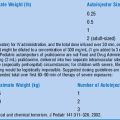Chapter 62 Thoracic Trauma
6 Describe signs and symptoms related to each operative thoracic injury
| Injury | Signs and Symptoms |
|---|---|
| Tracheal/bronchial rupture | Active chest tube air leak |
| Lung parenchyma | Chest tube bleeding > 2–3 mL/kg/hr |
| Internal mammary or intercostal artery laceration | Hypotension unresponsive to transfusions |
| Esophageal disruption | Abnormal esophagogram (leak) or esophagoscopic result Gastric contents in the chest tube |
| Diaphragmatic hernia | Abnormal gas pattern in hemithorax Displaced nasogastric tube in hemithorax |
| Pericardial tamponade | Positive pericardiocentesis |
| Great vessel laceration | Widened mediastinum Tracheal or nasogastric tube deviation Blurred aortic knob Abnormal aortogram (gold standard) |
7 What signs and symptoms are associated with pulmonary contusion?
Ruddy R: Trauma and the paediatric lung. Paediatr Respir Rev 6:61–67, 2005.
10 Should thoracic helical CT replace chest radiography in the initial management of blunt trauma in the pediatric patient?
No, even though helical CT has been shown to be more sensitive than chest radiography in diagnosing thoracic injuries, thoracic trauma makes up less than 20% of all pediatric traumas. Performing thoracic CT on all pediatric trauma patients would increase costs and patient radiation dose, with little clinical improvement. Thoracic CT should be used only in patients with suspected thoracic injury (see question 4).
20 How concerned should I be about blunt cardiac injury in patients with thoracic trauma?
1 The most common injuries in blunt thoracic trauma are lung contusions (58%), pneumothorax or hemothorax (38%), and rib fractures (38%).
2 Thoracic CT should be part of the initial evaluation of pediatric trauma patients if a lung contusion, pneumothorax, or a hemothorax is suspected or if the cause of the patient’s respiratory distress is unknown.
3 Myocardial contusion is the most common and ventricular rupture the most lethal of blunt cardiac injuries.
4 Patients with a traumatic rupture of the aorta may present with hypotension, paraplegia, anuria, or absent/diminished femoral pulses.
5 Radiographic findings of a traumatic rupture of the aorta may include a widened mediastinum, blurred aortic knob, pleural cap, or tracheal or nasogastric tube deviation.
6 Suspect commotio cordis and ventricular fibrillation in any patient who has become unconscious immediately after blow to the chest.
















